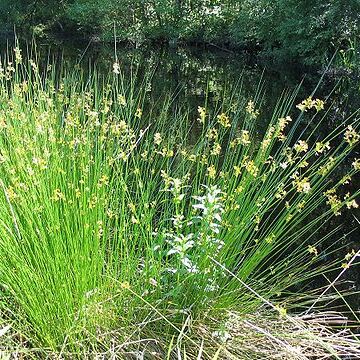Herbs, very rarely shrublike, perennial or annual, tufted or with erect or creeping rhizome. Stems erect, terete or laterally flattened. Leaves occasionally reduced to a bladeless or nearly bladeless sheath at base of stem (cataphyll); leaf sheath often shortly prolonged on both sides into a pair of auricles at leaf blade juncture; leaf blade of basal and cauline leaves usually linear or filiform, grasslike and flat, or terete, glabrous except for pilose margin on some grasslike blades. Inflorescence a panicle, corymb, or 1-flowered. Flowers bisexual or unisexual and plants dioecious, mostly wind pollinated, regular, usually small, usually 1-or 2-bracteolate at base. Perianth segments (3 or)6, in (1 or)2 whorls, free, usually greenish to brownish or blackish, rarely white or yellowish, glumelike. Stamens 3 or 6, if 6 then 3 opposite outer perianth segments; filaments thin; anthers basifixed, 2-loculed, dehiscing by longitudinal slits; pollen grains in tetrads. Ovary superior, 1-loculed, or divided by 3 septa and 3-loculed, or incompletely septate; ovules 3 and inserted at base of ovary, or numerous and biseriate on 3 parietal placentas. Stigmas 3, papillose. Fruit a capsule, 1--3-valved, loculicidal. Seeds globose, ovoid, or fusiform, small, sometimes appendaged; appendage caudate; embryo straight, minute, enclosed by fleshy endosperm.
Annual or perennial herbs, rarely shrubs. Roots fibrous. Stems erect, cylindric or rarely compressed, naked or leafy, sometimes rhizomatous or stoloniferous, and then horizontal or ascending. Leaves grass-like or cylindric, sheathing at the base, sometimes reduced to cataphylls; sheaths open and sometimes auriculate, or closed. Inflorescence terminal, often pseudo-lateral, compound or rarely simple with one flower, umbellate, paniculate, the flowers solitary or in capitula (heads); bracts leaf-like, scarious or membranous, persistent; bracteoles sometimes present. Flowers small, regular, hermaphrodite; rarely the plants dioecious. Perianth-segments 6, in two series, subequal, glumaceous, green or brown, usually membranous at the edges. Stamens 6, opposite and shorter than the perianth-segments, the 3 inner sometimes absent; filaments linear or triangular; anthers basifixed, 2-thecous, introrse, dehiscing longitudinally. Carpels 3, joined; ovary superior, 1-or 3-locular; style rarely absent; stigmas 3. Fruit a loculicidal capsule. Seeds 3 or many, ovoid to obovoid, apex sometimes apiculate, base sometimes tailed
Herbs, perennial, occasionally annual, usually rhizomatous, orsometimes cespitose. Culms round or flat. Leaves mostly basal; sheath margins fused or overlapping, often with 2 earlike extensions (auricles) at blade junction; blade flat or round, glabrous or margins hairy. Inflorescences of headlike clusters or single flowers variously arranged; bracts subtending inflorescence 1 or more2, mostly leaflike; bracts subtending inflorescence branches 1--2, reduced; bracteoles subtending solitary flower 0--2, translucent, reduced. Flowers usually bisexual, radially symmetric; sepals and petals similar, persistent, green to brown or purplish black; stamens usually 3 or 6; anthers persistent, linear; pistils 1; ovaries superior, locules 1 or 3, placentas 1 and basal or 3 and axile or parietal; stigmas generally longer than styles. Fruits capsules, loculicidal. Seeds 3--many, often with white appendages on 1 or both ends.
Leaves mostly in a basal tuft, grass-like, linear or filiform, sheathing at the base or reduced to a sheath, sheaths open or closed
Stamens 6 or 3, free; anthers 2-celled, basifixed, opening lengthwise; pollen in tetrads
Seeds sometimes tailed, with a small straight embryo in the middle of endosperm
Perianth-segments 6, in 2 whorls, or rarely only 3, usually glumaceous
Ovary superior, 1-celled or 3-celled; styles and stigmas 1 or 3
Flowers hermaphrodite or unisexual, usually very small
Ovules ascending or parietal, 3 or more
Perennial or annual herbs
Fruit a dry capsule

